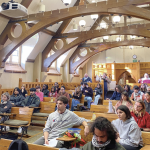For student writers, part of the so called “college experience” has always been to hone and perfect their work by means of student publications. The Trinity Tripod is a student publication, though it is a campus institution that dates back over one hundred years. The only other significant student publication on campus right now is the Beacon, a student-started, student run circular published each semester. Though this project has been successful, and has consistently featured a healthy amount of student contributions, it is notable and unusual that there are so few student-driven writing platforms on campus.
Comparing Trinity’s two writing platforms to those of another school of a similar situation and level reveals a contrast: Colby, for example, has four student-run writing platforms on its campus, including the school’s official newspaper. At the far end of the spectrum, perhaps predictably, is Wesleyan, whose website reports that there are seventeen active student publications on their campus. Though Wesleyan’s prolifically long list of publications is certainly far more developed and various than the normal writing culture of a liberal arts college, Trinity’s deficiency is thrown into stark contrast by this list. Among the other NESCAC schools, it is common to have at least a handful of student-writing platforms.
The difference harkens back to a debate as old as time for Trinity students: does this stagnation of campus culture result from an unwilling or uninterested student body, or does that unwillingness stem from the structures of the school itself? If the problem lies in the student body itself, then the issue is one of admission. Schools like Wesleyan simply accept more artistically, linguistically engaged students with more drive to publish their own work. If Trinity’s problem is symptomatic of an administrative misalignment of some kind, the problem might be said to be a lack of credit system. It is not uncommon for other colleges to actually pay their editorial staff for the hours of work they put into their paper. Yet it also seems likely that a large number of student-run writing outlets, many of which are artistic magazines, poetry platforms and other more avant-garde publications require no credit to function. Historically Trinity students have been less willing to participate when no compensation is offered them for their time and effort.
Publications of specific political views, or artistic subjects are more likely to form in the void left by a larger official newspaper: In the case of the Tripod, any interested writers are most likely to write for the Tripod alone without considering the possibility of joining or starting their own publication. Alternately, they become alienated by the Tripod, or frustrated by something they find lacking or overabundant in it. It is in this space that a properly motivated and encouraged student would create their own publication. Yet the absence of these startup publications indicates that the inspiration to cut one’s own path- to write for writing’s sake without the restrictions of a larger organization simply isn’t there.
The problems of Trinity’s vitality and culture are all interconnected and cannot be solved outright without the benefit of retrospect. The Tripod’s editorial staff believes, however, that it is the responsibility of powers within the administration to be more vocally supportive of students working on independent projects in the arts and writing. The more Trinity’s arts culture can exist independently of the official structures of the school, the healthier it will become in the future.


+ There are no comments
Add yours